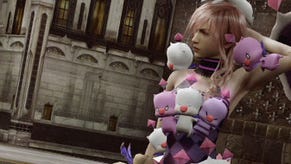Lightning Returns: Final Fantasy 13 shows that time isn't the best healer
Lightning Returns: Final Fantasy 13 puts players against the clock and drastically changes the tried format. VG247's Dave Cook has been playing a recent preview build to find that time doesn't always mend old wounds.
”Things do improve once you start to understand the demands of the time format and how to act efficiently, but you’re still sprinting between quests with obedience, stopping every so often to refill Lighting’s run stamina and cursing that bloody clock.”
Is the Final Fantasy series suffering from an identity crisis? That all depends on who you ask. Comparing the Fabula Nova Crystallis trilogy with the PSone classics certainly reveals a canyon of difference. Gone are the turn-based battles and world map exploration, replaced with reigned-in environments and fluid, oddly-named combat mechanics. It could be argued that Square Enix is simply keeping up with the times, but elements of Lightning Return's odd design have left this critic feeling puzzled, and at times, disappointed.
I didn't feel disappointment because the game is outwardly bad, but because there is a glimmer of a smart concept beneath the poorly-scripted exposition, unfortunate design flaws and at times, awkward combat. There was enough substance in the preview build I played to keep me keen for its full release, but I do have several concerns going forward. But first, some context.
The plot opens 500 years after the events of Final Fantasy 13-2 with the world teetering on the bring of ruin. Lightning awakens after a long slumber to find she has been chosen as god's saviour, charged with saving as many souls as possible and ferrying them to the new world. With 13 days on the clock and plenty of obstacles in her way, the pink-haired hero certainly has a grand task ahead of her. In short; it's Final Fantasy-meets-Dead Rising 3, a polarising blend if ever I've seen one.
At this point you need to ask yourself, 'What does the Final Fantasy series mean to me?' Personally, it's all about turn-based battles, running around in circles for hours to trigger random encounters and leisurely exploring vast world maps on the back of a Chocobo. That's a very different proposition to what's being served up here. Time is always against you, forcing you to sprint around each of the world's open regions.
At the outset you're asked to dash around the city of Luxerion, rushing from one dull fetch quest to the next. The idea is that by completing tasks you remove the darkness from the quest-giver's heart, saving their soul and earning you Eradia. At 6am every day Lightning is transported back to the Ark, a safe haven constructed by returning character Hope Estheim. Here, you'll bank all Eradia earned to wind back the doomsday clock and get a daily helping of plot waffle from Hope himself.
You start with five days until world's end, but if you're quick and efficient you can bring the clock back to a full 13. These quests can prove incredibly tedious however. One key mission sees you trying to find five hidden numbers painted on walls around the city of Luxerion. To narrow down their location you need to gather information by speaking with NPCs; a lot of them. The final number happens to be locked behind a gate that only opens between the hours of 00:00 and 06:00.
So if you're super-efficient and find yourself having to wait until midnight for the last number, you could hop the train to one of the Outerworld areas like the Wildlands or Dead Dunes. It's a half-hour journey to the Wildlands, so you need to be wary of how long it takes to get here and back, on top of everything you plan to do while there. Add to this the fact that certain NPCs only appear at specific times, and some areas are open between set hours and you have a disorganised person's idea of a waking nightmare. This is pressure I personally don't want in my Final Fantasy experience. It feels out of place, but I respect the fact that you might enjoy the mechanic.
If you need some respite from times cruel flow you can also use Chronostasis to halt the flow of time. it's one of several skills Lightning can trigger using AP points, which are earned through battle. While active, everything linked to the time mechanic will halt, which is useful if you need a few extra minutes to reach an NPC that's about to leave their position, or pass through a time-release door before it closes. You can also spend AP on healing Lighting with Curaga, entering Overclock mode - that lets you unleash rapid attacks - and revive after death. AP also lets you flee battle at no cost, but it does add an hour onto the clock.

The numbers quest mentioned above is truly frustrating; an error of design. I spent ages walking down uninspired back alleys in search of NPCs while sweating profusely over all the time I was wasting. Another example saw me searching for a fabled white Chocobo in the Wildlands by first speaking with NPCs (do you see the pattern yet?) and then searching some airship wreckage for its trail. I found it wounded next to a snarling beast far too strong for my current level. I couldn't beat it so had to return to Luxerion defeated, having wasted a ton of time on a simple beginner's trap.
Another example much later in the Dead Dunes saw Lightning venturing into ruins in search of relics. I fought my way in after passing some relatively simple encounters, picked up the object and turned around to find my way back blocked by unavoidable, much tougher enemies. I barely made it out of there alive, and had to reload my save to start the fights over multiple times because I was ill-equipped. That's simply poor design. I was lucky enough to have saved my progress just before the battle. Otherwise I'd have to go a long way back.
That's when it hit me: this game has been designed for multiple play-throughs, just like Dead Rising. I've looked at Japanese speed-runs of this game on YouTube that show players sprinting to objectives with prior knowledge, each taking very little time at all, avoiding all the pitfalls. The same is apparent in the combat system. On your first pass, you'll struggle to defeat what would commonly be regarded as a simple enemy without a long, drawn-out fight. It's lucky then, that the doomsday clock pauses while in battle.
Lightning's ability to switch outfits does more than fuel the Final Fantasy cosplay scene; it works a bit like Final Fantasy X-2's Dressphere system. Creating garbs is perhaps equally the smartest and silliest aspect of combat, but it comes with a great degree of customisation. Creating an outfit - or 'Schemata' - starts with a base garb, which often includes an embedded buff or skill. The Red Mage coat comes with a Max HP boost of 150, for example. From there you can add a sword, shield, accessories and attacks bought at stores or forged using synthesis.
You can, naturally, add cosmetic items on top of the useful clothing - such as pink heart hair clips or a Carbuncle plushie - but they bear no impact on Lightning's performance. The fact that she's being treated like a dress-up doll didn't sit quite right with me, but this isn't the place for that discussion. You'll do little fighting in the first few hours as you scramble around making people happy, but as you progress you'll need to create a balanced stock of Schemata types and skill load-outs that support one another. As such, the combat does improve over time, and that keeps me somewhat hopeful for the final build.

With three active Schemeta at any one time, you're actually taking three characters into battle instead of one, seeing as each of Lightning's outfits has its own ATB meter and only one health bar. Once the bar is depleted it's game over. Annoyingly, you can only carry a set number of restorative items at one time – six at last count, although I suspect this may increase over time. I tended to go for at least four X-Potions and two Phoenix Downs to cover myself, but you'll start to rue Square's design once you get knocked out during an impassable fight without another Phoenix Down to hand. I still don't fully understand why this item restriction has been forced on players, I really don't.
The key to winning battles is staggering your opponent, which is a returning feature from previous Final Fantasy 13 games. Using Lightning's Libra skill or through primers bought at stores, you can view a creature's stagger condition and weaknesses. Even using these conditions I found battles against simple monsters lengthy and arduous. Things even out once you level up – you level up by completing quests this time, not by grinding battles - and I even watched another Japanese play-through of one particularly laborious boss battle, only to see a new game+ completionist coast through it with ease.
I couldn't help but feel that combat was intentionally tough at the outset to encourage repeat play. At first I thought I was missing something or that perhaps my parry timing was all wrong, but I double-checked Libra, the YouTube video and the game's rules again to find that it was just the way of things. I wasn't having fun at the start. However, you'll relax more once you start to understand the demands of the time and battle mechanics. You'll also fight and race between tasks with increasing efficiency as you level up and unlock new shortcuts.
Opening a new map route by completing a key quest is actually really gratifying in a way Dark Souls fans appreciate. This game will make you work for such luxuries, so in a way this is perhaps the most 'hardcore' entry to the series yet – for lack of a better term. There's a lot still sprinting between quests with obedience in here, and it really does get old fast when you stop occasionally to refill Lighting's run stamina, or listen to more exposition-laden drivel, all the while cursing that bloody clock. This is not a game for everyone, that much is clear.
As our regular readers are aware, we at VG247 are not in the business of typical previews; so please do treat this as one veteran Final Fantasy fan's opinion. I also appreciate that many of you out there really dig the Dead Rising time format, so if that sounds like you there's every chance you'll get some sort of kick out of the game. I've also spoken at length about why the Dead Rising time management dynamic is not for me in this article.
To me, the most compelling aspect of this game was it's harrowing tone, which really does bring across the bleak outlook of humanity staring into oblivion. It's the end of days, and at times it really does feel like it. I'm yet to run out the clock, but I suspect those last few moments before the apocalypse starts are quite sombre; perhaps even reflective. Regrettably, I have to admit that Lightning Returns hasn't fully grabbed me yet, but I will certainly be giving it a solid try again at launch, purely because I'm still a fan of the series.
It may grow on me during a second pass, but let us know what you think of Lighting Returns: Final Fantasy 13 so far below.
Disclosure: To assist in writing this article, Square Enix sent Dave a PS3 debug copy of Lightning Returns: Final Fantasy 13.








